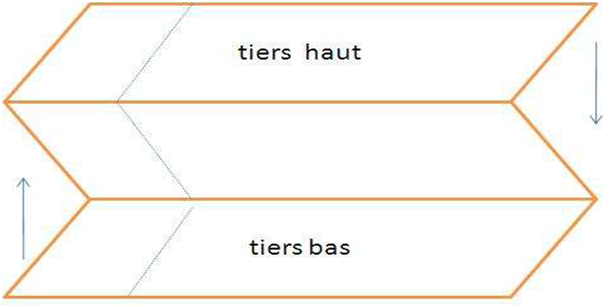THE ENVELOPE
a) Format
Common formats correspond to what we call the “square” envelope and the “long” envelope, i.e. 114 x 162 mm and 115 x 225 mm respectively.
b) Commercial envelope
Some envelopes, reserved for commercial use, are very practical: they have a transparent part in the usual place of the address. They are called „window envelopes‟.
They avoid typing the address twice and making a recipient mistake. We remind you that a 21
How do you fold a letter and put it in the envelope?
1st Case:
Where the envelope is long, you must make two folds (therefore three parts) in an accordion (see diagram 1) and insert it into the envelope in such a way as to have the first third where the addresses of the sender and recipient opposite.

2nd Case
Where the envelope is square, it will be necessary to fold it sideways again so that it can be inserted easily (see diagram 2).

a) Saving time: transmission of the message is fast and direct;
b) A low cost: price of a telephone call or flat rate price;
c) The possibility of communicating in real time or delayed, 24 hours a day;
d) Selective or, on the contrary, very broad diffusion.
II.4. The main messages of internal communication
Their function is essentially to relate facts, exchange and transmit information within the framework of the work. Their structure is therefore often sober: text, few or no images.
II.4. 1. The note
It is a document that transmits hierarchically (تدريجيا) instructions (memo) or information about the company (information note). The memo always circulates in a downward direction and is followed by implementation.
II.4. 2. Written expression
There is no real language specific to business mail, but the language adopted must exclude colloquial language and adapt to the recipient and the circumstances.
II.4. 3. Titles of civility
They are obligatory in business letters.
II.4. 4. Polite expressions
Polite expressions depend on the relationship between the sender and the recipient.
You write to a superior: “Please accept, Mr. Director, the expression of my respectful feelings. » or “Please accept, Sir, the expression of my devoted feelings. »
from superior to inferior: “I pray you to receive the assurance of my perfectness”
as equals: “I assure you of my distinguished greetings”
II.4. 5. Mandatory information
Any professional message must identify the sender and the recipient(s), specify the subject, references, place and date of issue.
Certain documents must comply with specific presentation rules.
Example: The business letter must be presented on company letterhead. It must include the signature of the issuer with an indication of his name and position.
II.4. 5. Typography
Typographic rules must be respected for hyphenation of words at the end of lines, abbreviations and even punctuation.
Examples. Do not cut a word in the middle of a syllable; use the abbreviation “cm” for “centimeters”; put a space before a semicolon.
Typography highlights certain information by creating contrasts. The development of the use of word processing software has made it possible, through the power of their functions, to reinforce quality requirements. For example :
The choice of font type must be relevant and adapted to the nature of the writing;ü
Example. Classic fonts (Arial, Times, etc.) are used for letters and notes, while more fancy fonts (إبداع) (Comic Sans MS, etc.) can be adopted for an invitation card or a flyer (نشرة دعائية).
Font size 12 is recommended for body text, while a larger size is reserved for titles and subtitles;ü
The “bold” style is preferred to underlining, which makes the message heavierü



